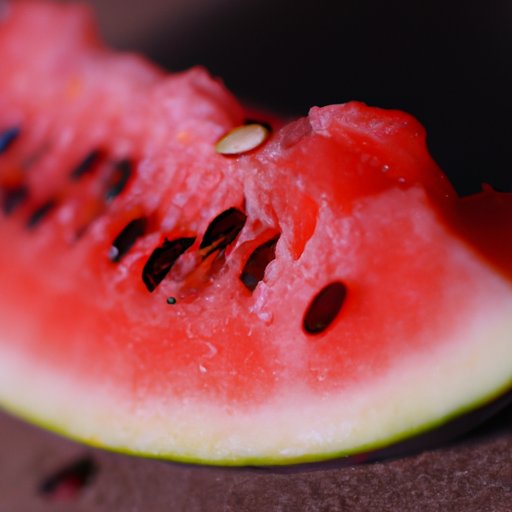
I. Introduction
Watermelon is a summer favorite for many people. When purchasing a watermelon, it is important to be able to determine if it is fresh and ripe. A bad watermelon can ruin a meal or gathering, leading to disappointment and wasted money. This article will provide you with tips and techniques to help you identify bad watermelon.
II. Identifying the Sound
The sound a watermelon makes can be a good indicator of its ripeness and freshness. A ripe watermelon will produce a hollow sound when tapped. To determine if a watermelon is bad based on sound:
- Hold the watermelon close to your ear
- Tap the watermelon gently with your knuckles
- Listen for a hollow or deep sound
- A dull or high-pitched sound indicates a bad watermelon
III. Checking the Weight
The weight of a watermelon can also indicate its freshness. A ripe watermelon should feel heavy for its size. To weigh a watermelon:
- Lift the watermelon with both hands
- Compare the weight to other watermelons of a similar size
- If it feels lighter than expected, it may be a bad watermelon
IV. Examining the Skin
The skin of a watermelon can provide clues about its freshness. A fresh watermelon’s skin should be smooth and uniform. To examine the skin:
- Look for any dents, soft spots, or bruises
- Check for any mold, mildew, or discoloration
- Scratch the surface of the watermelon with your fingernail to see if the skin is tough
- Bad watermelons may have scratches or punctures on the skin
V. Smelling the Melon
The aroma of a watermelon can also indicate its freshness. A ripe watermelon should have a sweet smell. To smell the watermelon:
- Hold the watermelon under your nose
- Take a deep sniff
- A rancid or sour smell indicates a bad watermelon
VI. Looking at the Stem
The stem of a watermelon can be a useful tool in identifying its freshness. A fresh watermelon will have a green stem. To check the stem:
- Look at the stem closely to see if it is green or brown
- A brown stem indicates the watermelon is overripe
- A green stem indicates the watermelon is fresh
VII. Checking the Color
The color of a watermelon’s flesh and skin can also be indicators of its freshness. A ripe watermelon’s flesh should be bright pink or red and the skin should be dark green. To check the color:
- Look for any yellow or white spots on the flesh
- A yellow or white spot indicates an unripe watermelon
- Check the skin for any dullness or discoloration
VIII. Taste Test
The final step in identifying a bad watermelon is the taste test. A fresh watermelon should be sweet and juicy. To conduct a taste test:
- Cut a small piece of the watermelon
- Taste the watermelon for sweetness and juiciness
- A sour or bland taste indicates a bad watermelon
IX. Conclusion
It is important to be able to identify bad watermelons to avoid disappointment and wasted money. By using the tips and techniques outlined in this article, you can confidently purchase fresh and ripe watermelons for your summer fun.
Remember to listen for the sound the watermelon makes when tapped, check its weight, examine the skin for imperfections, smell the watermelon for freshness, look at the stem, check the color of the flesh and skin, and conduct a taste test. With this knowledge, you are ready to purchase fresh, delicious watermelons for your summer gatherings.





